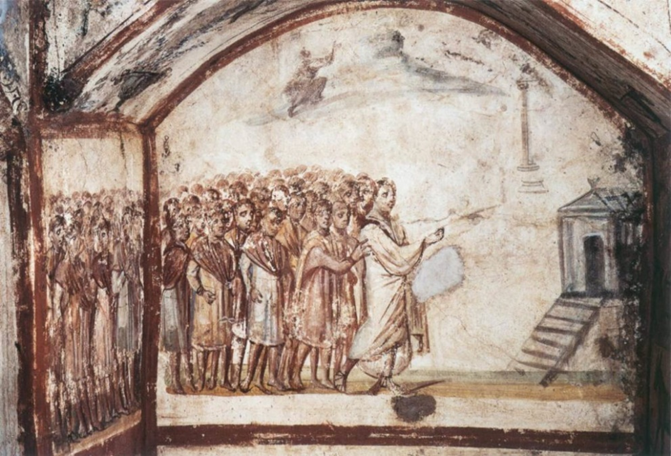By: Dcn. Paul Born
Saint John's Seminary │ Theology IV│ Archdiocese of Boston
The raising of Lazarus is one of the common images found in the ancient Christian cemeteries around Rome. The funerary image was clear. The Christian dies wrapped in the hope of resurrection with the Lord. Persecuted Christians gathered in these cemetery catacombs for prayer, celebrating Mass on the tombs of the holy martyrs, learning from the saints, as well as from these frescoes. One fresco depicts Christ pointing into Lazarus’ open grave. The latter stands erect, wrapped in his burial cloths, looking around for what has happened. Christ is much larger, in the foreground, dressed as a Roman citizen. The fresco shows that God acts by His own power to save, needing nothing else to overcome evil. In another ancient catacomb, Christ is depicted as the head of a large crowd, pressing behind Him, to see what will happen at Lazarus’ tomb. Despite the crowd, no one steps in front of Jesus. He points across a gap towards the open door of the tomb, giving out that loud cry that raised His friend. Again, the powerful encounter between God and man is depicted—now with all to see.

The Christian hope of salvation and resurrection is founded on revelation that Almighty God glorifies in our salvation. This is what heard last week—that the man born blind was not blind because of his own sins, nor because of those sins of his parents, but rather so that God might be glorified in the healing. Now, one week before Palm Sunday, Christ again tells us that Lazarus is allowed to die so that in his raising, God might be glorified. For this reason, ancient Christians would contemplate the Samaritan woman, the man born blind, and Lazarus during Lent, as we have this year, these last three Sundays. In each of these, we see the drama of the personal encounter of the Almighty Savior, who seeks out those who have been left aside.
Those early communities took comfort, amidst their persecution, in the Lord’s mercy—not only for their physical hope of healing, but for the hope of the healing of their souls. We, as they did, do not go through Lent as an exercise as a self-help exercise, but as a God-help exercise. Fasting, prayer, and almsgiving are the holy ways to reattach ourselves to the hope given in Christ. We rely more on the Lord, and place ourselves, in a way, in a new encounter with His power and mercy. When we have died from sin, He waits for us at the well of the confessional, ready to call us out of our grave, “come out!”, in the absolution. He unburdens us and sets us free: “untie him and let him go.” Glory to God, Who glories in our salvation!


